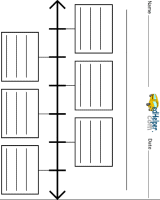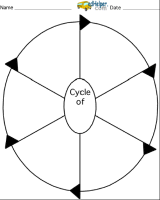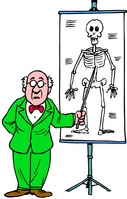v Recognize body systems and the interaction of cells, tissues, and organs to support growth and survival.
a. Systems consist of tissues and organs which are made of cells.
b. Discuss Tissue types Muscular, Smooth, Cardiac
c. Human body systems and functions:
· muscular, skeletal, digestive, circulatory, respiratory,
excretory, nervous, endocrine, and reproduction Ropes
| Body Systems Work Together By Cindy Grigg |  |
 1 You know that your body is made of cells. When groups of cells do the same kind of work, they are called tissues. The word tissue comes from a Latin word meaning to "weave." Cells that make up tissues are sometimes "woven" together.
1 You know that your body is made of cells. When groups of cells do the same kind of work, they are called tissues. The word tissue comes from a Latin word meaning to "weave." Cells that make up tissues are sometimes "woven" together.2 You have four main types of tissues: epithelial, nervous, muscle, and connective tissue. Epithelial tissue covers the outside of the body. It also lines organs and cavities. Nervous tissue sends electrical signals. Muscle tissue helps you move. Connective tissue joins bones and cushions organs.
3 When groups of tissues work together, they are called organs. Some examples of organs are the heart, lungs, skin, and stomach. When organs work together, they are called systems. For example, your heart, lungs, blood, and blood vessels work together. They make up the circulatory system.
There are eleven systems in the human body: muscular system, respiratory system, digestive system, integumentary system (skin), skeletal system, circulatory (or cardiovascular) system, excretory (or urinary) system, reproductive system, nervous system, lymphatic system, and endocrine system. Each system has a special job.
Please copy this graphic organizers in your journal and complete it from the reading above in your journal
5 parts 6 parts
Please copy this graphic organizers in your journal and complete it from the reading above in your journal
5 parts 6 parts
____________________________________
5 All of your body systems have to work together to keep you healthy. Your bones and muscles work together to support and move your body. Your respiratory system takes in oxygen from the air. It also gets rid of carbon dioxide.
6 Your digestive system absorbs water and nutrients from the food you eat.
7 Your circulatory system carries oxygen, water, and nutrients to cells throughout your body. Wastes from the cells are eliminated by your respiratory system, your excretory system, and your skin. Your nervous system controls all these activities with electrical impulses. If any system in your body isn't working properly, other systems are affected.
5 All of your body systems have to work together to keep you healthy. Your bones and muscles work together to support and move your body. Your respiratory system takes in oxygen from the air. It also gets rid of carbon dioxide.
6 Your digestive system absorbs water and nutrients from the food you eat.
7 Your circulatory system carries oxygen, water, and nutrients to cells throughout your body. Wastes from the cells are eliminated by your respiratory system, your excretory system, and your skin. Your nervous system controls all these activities with electrical impulses. If any system in your body isn't working properly, other systems are affected.
Please copy this graphic organizers in your journal and complete it from the reading above in your journal
8 Think of your body as a building. A building has a plumbing system, a heating system, a cooling system, an electrical system, and a support system. If any system in a building breaks down, other systems can be affected.
9 As one example, think about a building's electrical system. Suppose a mouse chewed through an electrical wire to a furnace. Without electricity, the heating system would not work. If this happened in very cold weather, the plumbing system could be affected. Water pipes might freeze and burst. If a lot of water leaked into the building's walls, its support system would be damaged. Like a building's systems, your body's systems have to work together.
Please summarize the last paragraph in 2-4 sentences
Copyright © 2011 edHelper
Copyright © 2011 edHelper
| _____________________________ |  | Date ___________________ |
|
| ||||
|
| ||||
|
| ||||
|
|
| _____________________________ |  | Date ___________________ |
| _____________________________ |  | Date ___________________ |
| Body Systems Work Together By Cindy Grigg |  |
Directions: Fill in each blank with the word that best completes the reading comprehension.
 You know that your body is made of cells. When groups of cells do the same kind of work, they are called tissues. The word tissue comes from a Latin word meaning to "(1) _______________________ ." Cells that make up tissues are sometimes "(2) _______________________ " together.
You know that your body is made of cells. When groups of cells do the same kind of work, they are called tissues. The word tissue comes from a Latin word meaning to "(1) _______________________ ." Cells that make up tissues are sometimes "(2) _______________________ " together.You have four (3) _______________________ types of tissues: epithelial, nervous, muscle, and connective tissue. Epithelial tissue covers the outside of the body. It also (4) _______________________ organs and cavities. Nervous tissue sends electrical signals. Muscle tissue helps you (5) _______________________ . Connective tissue joins bones and cushions organs.
When groups of tissues work together, they are called organs. Some (6) _______________________ of organs are the heart, lungs, skin, and stomach. When organs work together, they are called systems. For example, your heart, lungs, blood, and blood vessels work together. They make up the circulatory system.
There are eleven systems in the human body: muscular system, respiratory system, digestive system, integumentary system (skin), skeletal system, circulatory (or (7) _______________________ ) system, excretory (or (8) _______________________ ) system,(9) _______________________ system, nervous system, (10) _______________________ system, and(11) _______________________ system. Each system has a special job.
All of your body systems have to work together to keep you healthy. Your bones and muscles work together to support and move your body. Your respiratory system takes in oxygen from the air. It also gets rid of (12) _______________________ dioxide.
Your (13) _______________________ system absorbs water and nutrients from the food you eat.
Your circulatory system carries oxygen, water, and nutrients to cells (14) _______________________ your body. Wastes from the cells are eliminated by your respiratory system, your (15) _______________________ system, and your skin. Your nervous system controls all these activities with electrical impulses. If any system in your body isn't working properly, other systems are affected.
Think of your body as a building. A building has a plumbing system, a heating system, a cooling system, an electrical system, and a support system. If any system in a building breaks down, other systems can be affected.
As one (16) _______________________ , think about a building's electrical system. Suppose a mouse chewed through an(17) _______________________ wire to a furnace. Without electricity, the heating system would not work. If this happened in very cold weather, the plumbing system could be affected. Water pipes might freeze and burst. If a lot of water leaked into the building's walls, its support system would be damaged. Like a building's systems, your body's systems have to work together.
Copyright © 2011 edHelper
| _____________________________ |  | Date ___________________ |
|
| ||||
|
| ||||
|
| ||||
|
|
Assignment= Please play with this site below and take 20+ notes on what you learn in your journal
http://www.innerbody.com/image/musfov.html

| The Digestive System By Sharon Fabian |  |
 1 The digestive system is the group of organs that breaks down food so that the body can use it. Food must be broken down all the way to its individual molecules to be useable. This involves a number of steps, and different organs to do different parts of the job.
1 The digestive system is the group of organs that breaks down food so that the body can use it. Food must be broken down all the way to its individual molecules to be useable. This involves a number of steps, and different organs to do different parts of the job.2 Once food is broken down it provides energy for many essential body functions. It provides the energy for all of our physical activity such as walking, playing sports, working, and talking. It also provides the energy for other, more automatic, activities including breathing and thinking. Food provides the energy for the nerves, muscles, and organs, including the heart, to continue working. It provides the fuel to build and repair body tissues. Food energy is needed to regulate body organs and systems. It is the fuel that provides heat to keep our body temperature at a steady 98.6 degrees.
3 The digestive process begins in the mouth. There, the teeth and the muscles of the mouth begin the digestive process by breaking down the food into smaller bits. Saliva, produced by the salivary glands, begins to digest the food before it is even swallowed. Saliva and the other chemicals produced along the way to speed the digestive process are called digestive enzymes.
4 Next, muscles in the throat help swallow the food, and it passes through a long tube called the esophagus. The esophagus goes from the throat to the stomach. In the stomach, a digestive fluid called gastric juice mixes with the food. The stomach muscles toss the food and the gastric juices, and break down the protein parts of the food. Other parts of the food will not be broken down for several more hours.
5 The food is now a thick liquid, and it leaves the stomach to pass into the small intestine. In the small intestine more digestive enzymes act on the food. Pancreatic juice, from the pancreas, and bile, produced in the liver and stored in the gall bladder, continue to break down various parts of the food. They complete the digestion of starches, sugars, and fats.
6 As the food becomes completely digested it gets absorbed into the bloodstream by tiny blood vessels in the wall of the small intestine. At this point the food has been broken down to its molecules, and the energy from the food travels to wherever it is needed in the body, by way of the bloodstream.
7 The parts of the food that cannot be digested then pass into the large intestine. These parts include fibers, or roughage. There they are stored and broken down further by the action of bacteria, until they are expelled from the body through the rectum.
8 The whole system that the food passes through is called the alimentary canal. Its main parts are the mouth, the esophagus, the stomach, the liver, the gall bladder, the pancreas, the small intestine, the large intestine, and the rectum. Some of its main chemicals are saliva, gastric juice, pancreatic juice, and bile. It's the system that provides the energy that keeps us alive and active -- the digestive system.
Copyright © 2011 edHelper

Please pick one of these graphic organizers and copy these it in your journal and list the sequence steps of digestion in this graphic organizer in your journal

| _____________________________ |  | Date ___________________ |
|
| ||||
|
| ||||
|
| ||||
|
|
Assignment= Please play with this site below and take 20+ notes on what you learn in your journal @
http://www.innerbody.com/image/digeov.html
| _____________________________ |  | Date ___________________ |
| _____________________________ |  | Date ___________________ |
| _____________________________ |  | Date ___________________ |
| The Digestive System By Sharon Fabian |  |
Directions: Fill in each blank with the word that best completes the reading comprehension.
 The digestive system is the group of organs that breaks down food so that the body can use it. Food must be broken down all the way to its (1) _______________________ molecules to be useable. This involves a number of steps, and different organs to do different parts of the job.
The digestive system is the group of organs that breaks down food so that the body can use it. Food must be broken down all the way to its (1) _______________________ molecules to be useable. This involves a number of steps, and different organs to do different parts of the job.Once food is broken down it (2) _______________________ energy for many (3) _______________________ body functions. It provides the energy for all of our physical (4) _______________________ (5) _______________________ as walking, playing sports, working, and talking. It also provides the energy for other, more (6) _______________________ ,(7) _______________________ including breathing and thinking. Food provides the energy for the nerves, muscles, and organs, including the heart, to continue working. It provides the fuel to build and repair body tissues. Food energy is needed to regulate body organs and systems. It is the fuel that provides heat to keep our body temperature at a steady 98.6 degrees.
The digestive process (8) _______________________ in the mouth. There, the teeth and the muscles of the mouth(9) _______________________ the digestive process by breaking down the food into smaller bits. Saliva, produced by the salivary glands, begins to digest the food before it is even swallowed. Saliva and the other chemicals produced(10) _______________________ the way to speed the digestive (11) _______________________ are called digestive enzymes.
Next, muscles in the throat help swallow the food, and it passes through a long tube called the esophagus. The esophagus goes from the throat to the stomach. In the stomach, a digestive fluid called gastric juice mixes with the food. The stomach muscles toss the food and the gastric juices, and break down the protein parts of the food. Other parts of the food will not be broken down for several more hours.
The food is now a thick liquid, and it leaves the stomach to pass into the small intestine. In the small intestine more digestive enzymes act on the food. Pancreatic juice, from the pancreas, and bile, produced in the liver and stored in the gall bladder,(12) _______________________ to break down various parts of the food. They complete the digestion of starches, sugars, and fats.
As the food becomes completely digested it gets absorbed into the bloodstream by tiny blood vessels in the wall of the small intestine. At this point the food has been broken down to its molecules, and the energy from the food travels to(13) _______________________ it is needed in the body, by way of the bloodstream.
The parts of the food that cannot be digested then pass into the large intestine. These parts include fibers, or roughage. There they are stored and broken down further by the (14) _______________________ of bacteria, until they are expelled from the body through the rectum.
The whole system that the food passes through is called the alimentary canal. Its main parts are the mouth, the esophagus, the stomach, the liver, the (15) _______________________ bladder, the pancreas, the small intestine, the large intestine, and the rectum. Some of its (16) _______________________ chemicals are saliva, gastric juice, pancreatic juice, and bile. It's the system that provides the energy that keeps us (17) _______________________ and active -- the digestive system.
Copyright © 2011 edHelper
4
| Your Bones By Cindy Grigg |  |
 1 Have you ever wondered what your bones are good for? Why do we have bones, anyway? Your body needs help to stand nice and tall and to move. You can stand and move because you have bones and muscles. The bones of your body make up your skeleton. Your skeleton holds you up. Your bones also work with your muscles to help you move.
1 Have you ever wondered what your bones are good for? Why do we have bones, anyway? Your body needs help to stand nice and tall and to move. You can stand and move because you have bones and muscles. The bones of your body make up your skeleton. Your skeleton holds you up. Your bones also work with your muscles to help you move.2 Have you ever used a hand puppet? It just lies there on the table until you put your hand inside it. Your hand makes the puppet move. Your hand inside the puppet gives the puppet support. That means your hand holds up the puppet. Your skeleton does the same things for your body. Your bones make up the skeletal system. Your body has several different systems. The muscular system is the system of muscles that make up your body.
3 Your bones help protect the organs inside your body. Look at a picture of a skeleton. Do you see the ribs? The rib bones protect the heart and lungs. Look at the head of the skeleton. Those hard bones that are tightly joined together all around the head protect the brain.
Please copy this graphic organizers in your journal and complete it from the reading above in your journal

4 Look at the different shapes of the bones of a skeleton. Do you see that the long and thin parts of your body have long thin bones? The bones in the arms and legs are long and thin. Notice how the ribs curve around to give the upper body a round shape. The bones of the pelvis give the lower body a round shape.
5 The place where two different bones come together is called a joint. Your arm bones join at the shoulder. You can swing your arms in a circle if you want to. That‘s because of the type of joint you have in the shoulder. It is called a "ball and socket" joint.
Please copy this graphic organizers in your journal and complete it from the reading above in your journal
6 This type of joint lets you move your arm around and around in almost any way. The end of one bone is rounded, like a ball. It fits into a cupped bone that looks a little like a light socket. The "ball" bone fits into the "socket" bone like a light bulb fits into a light socket. This lets you move your arms in many ways. You have a ball and socket joint in your hips, too. You can also move your legs in many ways.
7 You have a different type of joint in your elbow. You can not move your lower arm around in a circle, can you? It will only bend in one way. This kind of joint is called a "hinge" joint. That's because it is like the hinge on a door. It only moves in one way. Different kinds of joints allow bones to move in different ways.
Please copy this graphic organizers in your journal and complete it from the reading above in your journal

8 You need your bones! Bones give your body support. Bones help your body move. Your bones are called the skeletal system. Bones have one more important job. They store minerals like calcium for your body. Some bones protect organs inside your body. You have different kinds of bones. The place where two bones join together is called a joint. Different kinds of joints allow your body to move in different ways.
Copyright © 2011 edHelper
Assignment= Please play with this site below and take 20+ notes on what you learn in your journal @
| _____________________________ |  | Date ___________________ |
|
| ||||
|
| ||||
|
|
| Name _____________________________ |  | Date ___________________ |
| _____________________________ |  | Date ___________________ |
| Your Bones By Cindy Grigg |  |
Directions: Fill in each blank with the word that best completes the reading comprehension.
 Have you ever wondered what your bones are good for? Why do we have bones, anyway? Your body needs help to stand nice and tall and to move. You can stand and move because you have bones and muscles. The bones of your body make up your skeleton. Your skeleton holds you up. Your bones (1) _______________________ work with your muscles to help you (2) _______________________ .
Have you ever wondered what your bones are good for? Why do we have bones, anyway? Your body needs help to stand nice and tall and to move. You can stand and move because you have bones and muscles. The bones of your body make up your skeleton. Your skeleton holds you up. Your bones (1) _______________________ work with your muscles to help you (2) _______________________ .Have you ever used a hand puppet? It just lies there on the table until you put your hand inside it. Your hand makes the puppet move. Your hand inside the puppet gives the puppet(3) _______________________ . That means your hand(4) _______________________ up the puppet. Your skeleton does the same things for your body. Your bones make up the skeletal system. Your body has several different systems. The muscular system is the system of muscles that make up your body.
Your bones help protect the organs inside your body. Look at a picture of a skeleton. Do you see the ribs? The rib bones protect the (5) _______________________ and lungs. Look at the head of the skeleton. Those hard bones that are tightly (6) _______________________ together all around the head(7) _______________________ the brain.
Look at the different shapes of the bones of a skeleton. Do you see that the long and thin parts of your body have long thin bones? The bones in the arms and legs are long and thin. Notice how the ribs curve around to give the (8) _______________________ body a round shape. The bones of the pelvis give the lower body a round shape.
The place where two different bones come together is called a joint. Your arm bones(9) _______________________ at the shoulder. You can swing your arms in a(10) _______________________ if you want to. That‘s because of the type of joint you have in the shoulder. It is called a "ball and socket" joint.
This type of joint lets you move your arm around and around in almost any way. The end of one bone is rounded, like a ball. It fits into a cupped bone that looks a little like a light socket. The "ball" bone fits into the "socket" bone like a light (11) _______________________ (12) _______________________ into a light socket. This lets you move your arms in many ways. You have a ball and socket joint in your hips, too. You can also move your legs in many ways.
You have a different type of joint in your (13) _______________________ . You can not move your(14) _______________________ arm around in a circle, can you? It will only bend in one way. This kind of joint is called a "hinge" joint. That's because it is like the hinge on a door. It only(15) _______________________ in one way. Different kinds of joints allow bones to move in different ways.
You need your bones! Bones give your body support. Bones help your body move. Your bones are called the skeletal system. Bones have one more (16) _______________________ job. They store minerals like(17) _______________________ for your body. Some bones protect organs inside your body. You have different kinds of bones. The place where two bones join together is called a joint. Different kinds of joints allow your body to move in different ways.
Copyright © 2011 edHelper
Assignment= Please play with this site below and take 20+ notes on what you learn in your journal @
Cardiovascular system
http://www.innerbody.com/anim/card.html







The self testing questions you have provided seem nice. I am going to attempt them. Wish me luck.
ReplyDelete